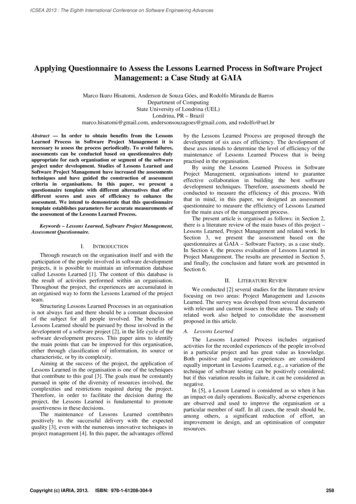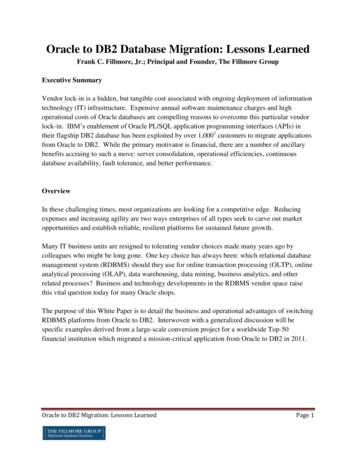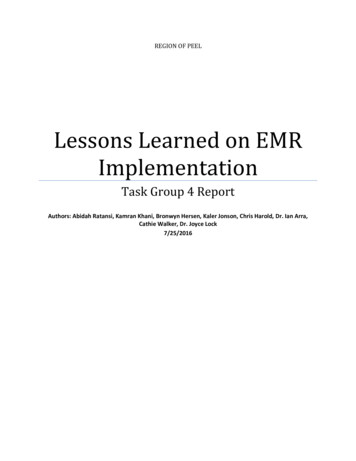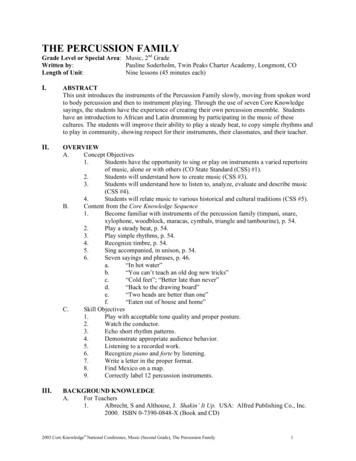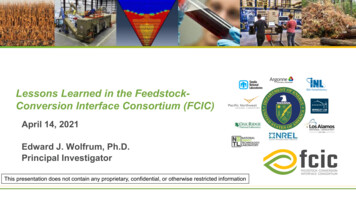
Transcription
Lessons Learned in the FeedstockConversion Interface Consortium (FCIC)April 14, 2021Edward J. Wolfrum, Ph.D.Principal InvestigatorThis presentation does not contain any proprietary, confidential, or otherwise restricted information
1-slide guide to the FCICThe Feedstock-Conversion Interface Consortium is led by DOE as acollaborative effort among researchers from 9 National LabsKey Ideas Biomass feedstock properties are variable and different from othercommodities Empirical approaches to address these issues have beenunsuccessfulWe are developing firstprinciples based knowledgeand tools to understand andmitigate the effects of biomassfeedstock and processvariability on biorefineries2
FCIC Task OrganizationFeedstockPreprocessingConversionTask X: Project Management: Provide scientificleadership and organizational project managementTask 1: Materials of Construction: Specify materials thatdo not corrode, wear, or break at unacceptable ratesTask 2: FeedstockVariabilityTask 5:PreprocessingTask 1: Materials of ConstructionTask 6: ConversionHigh-TempTask 7: ConversionLow-TempTask 3: Materials HandlingTask 2: Feedstock Variability: Quantify & understand thesources of biomass resource and feedstock variabilityTask 3: Materials Handling: Develop tools that enablecontinuous, steady, trouble free feed into reactorsTask 4: Data Integration: Ensure the data generated inthe FCIC are curated and stored – FAIR guidelinesEnabling TasksTask X: Project ManagementTask 4: Data IntegrationTask 8: TEA/LCATask 5: Preprocessing: Enable well-defined andhomogeneous feedstock from variable biomass resourcesTask 6 & 7: Conversion (High- & Low-Temp Pathways):Produce homogeneous intermediates to convert intomarket-ready productsTask 8:Crosscutting Analyses TEA/LCA: Valuation ofintermediate streams & quantify variability impact
Key Learnings4
Quality by Design (QbD)Critical Process ParameterProcess parameter that impacts aCQA Key operating concept andorganizing principle Widely used in pharmaceuticalmanufacturing – FDA-endorsed Chemical processes arecollections of specific unitoperations Unit operations are discrete butconnected Need fundamentalunderstanding of–Unit operation–Input & Output streamsCPPCMAInputmaterialCritical Material AttributeProperty of input materialthat is necessary to obtaindesired quality of productOutputmaterialUnitOperationCQACritical Quality AttributeProperty that must beachieved to obtain desiredquality of product5
QbD is about Feedstock Attributes . Moving from feedstock NAMES to feedstock ATTRIBUTES Physical Attributes Chemical Attributes Mechanical Attributes6
Critical Attributes Manifest at Different Scales Mechanical CMAs (stress/strainrelationships) influence comminutionperformance Molecular-scale modeling suggestschemical composition can affect bulkscale mechanical CMAs7
CQAs Can Skip Unit Operations Structural carbohydrates are influenced bygenetics, harvest and storage They do not directly impact preprocessing but arecritical in low-temperature conversion – yield isking8
Critical Attributes Can Influence (and be Influenced by)Multiple Unit Operations Inorganics can be affected by harvest,storage, preprocessing unit operations Inorganics in woody materials affect fastpyrolysis yields Inorganics affect equipment wear inmultiple unit operations9
Investments in Preprocessing Can Yield Dividends inConversion Corn Stover anatomical fractions show different yieldsin low-temperature conversion - DMR/EG Low-cost fractionation upstream will permit flexibleconversion approaches – campaigning materials?10
Material Wear in Processing Equipment can bePredicted and MitigatedMathematical models of erosive wear validated against experimental data used to predict the impact of feedstockCMAs, materials of construction, andprocess parameters (CPPs) on erosivewearWornCommercialhammer millToolsteelsCommercialknife millNi and FeBoriding oftool steels11
Questions?energy.gov/fcic12
Additional Information on the FCIC13
FCIC PublicationsFCIC Researchers are publicizing the details of their work in multiple ways –primarily in FY20 with peer-reviewed publicationsPublication Type FY20 CountJournal ArticlesPresentationsBook ChaptersPostersFact fcic-publications14
FCIC Contact InformationEdward J. Wolfrum, Ph.D.Principal InvestigatorFeedstock Conversion Interface research/staff/ed-wolfrum.htmlAmie SluiterProject ManagerFeedstock Conversion Interface v/research/staff/amie-sluiter.html15
Feedstock Variability TaskObjective: Identify & quantify the initial distribution of feedstock CMAs and inform strategies to reduce andmanage this variabilityImpact: Characterization tools and CMA variability data that inform 1) storage and harvest best practices, 2)feedstock quality, and 3) selection of process configurations that manage variability from field throughconversion Feedstock suppliers, process designers, equipment manufacturers, & investors will derive value fromthis fundamental knowledge of economic drivers that are critical to de-risking the industryOutcome: Understanding of key sources of biomass variability (e.g., storage degradation, harvest conditions,anatomical fractions, genetics, location) to identify and quantify CMA distributions that propagateacross unit operations to inform cost-effective management of variability across the value chain.16
Material Handling TaskObjective: Develop first-principles-based design tools that enable continuous, steady, trouble-free bulk flowtransport through processing train to reactor throat.Impact: This task provides industry with characterization tools and CMA variability data that inform 1) storage andharvest best practices, 2) feedstock quality, and 3) selection of process configurations that managevariability from field through conversion Feedstock suppliers, process designers, equipment manufacturers, & investors will derive value from thisfundamental knowledge of economic drivers that are critical to de-risking the industryOutcome: First principles-based design tools derived from validated models for equipment designers to ensurereliable continuous bulk solids handling and transport. Identify the safe and reliable working envelope ofCMAs, CQA for achieving CPP’s (i.e., design charts for consistent flow) Open-source constitutive models as ABQUS FEM and OpenFOAM FVM modulesPotential Customers & Outreach Plan: Publications of peer-reviewed scientific journals (with open access whenever possible) to promoteknowledge, tools and collaborations Open-source strategy in flow simulators, experimental data and design charts to attract investors,process designers, equipment manufactures CRADA projects between industry and labs to enable simulations on HPC17
Preprocessing TaskObjective: Develop science-based design and operation principles informed by TEA/LCAthat result in predictable, reliable and scalable performance of preprocessing unitoperations.Impact: This task will provide knowledge and tools to pioneer biorefineries and otherindustry stakeholders through fundamental studies of comminution, fractionation, anddeacetylation that produce validated mechanistic models.Outcome: A first-principles-based set of modeling tools that predict how material attributesof corn stover and pine residues and process parameters of milling, size classification anddeacetylation unit operations interact to produce feedstocks with quality attributes requiredby downstream conversion.Potential Customers & Outreach Plan: Publications of peer-reviewed scientific and trade journals to promote knowledge, toolsand collaborations and presentation of work at relevant conferences and trade shows Open-source strategy for all model codes Incorporate design aspects and control capabilities to mitigate feedstock variabilityimpacts to next-generation equipment designs and share results with equipmentmanufacturers.18
High Temperature Conversion TaskObjective: Develop the science-based understanding required to accurately predict the effects of variable feedstockattributes (CMAs) and process parameters (CPPs) on pyrolysis product quality attributes (CQAs).Impact: Feedstock impacts on high-temperature unit operations are either not known or are poorly-defined. Currentdesign principles are based on empirically-derived guidelines that are only useful over a very narrow range of feedstockproperties. The work from this task will allow biorefinery designers and operators will be able to design hightemperature unit operations/processes that are flexible and responsive to natural and market feedstock variability, whilemaximizing productivity.Outcome: A validated, multiscale experimental andcomputational framework allowing biorefinerydesigners/operators to maximize productivity and qualitywith variable incoming feedstock.Potential Customers & Outreach Plan:Potential customers include biorefinery designers andoperators. We will communicate new tools to them throughpublications, presentations, and IAB engagement.19
Low Temperature Conversion TaskObjective: Determine the effects of biomass feedstock variability on the low-temperature conversion process chain (bothsugar and lignin pathways) and develop tools to mitigate the risks posed by this variability.Impact: The interdisciplinary research team in this Task is uncovering knowledge and developing tools that minimize theimpacts of feedstock and process variability. As a result, the sequential cascade of low-temperature processes canintelligently operate by understanding critical attributes of materials passed downstream and by adjusting process parametersthat allow for tolerance of upstream complications.Outcome: Knowledge and tools that mitigate the risks posed by feedstock variability on theperformance of low-temperature conversion processes – minimizing variability upstream via firstprinciples understanding of CMAs that facilitates performance predictability for future lowtemperature processes with changes to CPPs downstream .Potential Customers & Outreach Plan: We willproduce a robust, validated predictive model for theeffects of feedstock and process variability on biocatalystperformance. The model (and the approach) will be ofinterest to the biomanufacturing industry. We willpublicize this work in peer-reviewed journal articles andwill identify industry stakeholders (starting with the IAB)to communicate with directly.20
Crosscutting Analyses TaskObjective: Quantify and communicate industrially relevant, system-level cost andenvironmental impacts for the discoveries and innovations of the FCIC throughwell-documented Case Studies to quantify how feedstock variability affectsunderlying economics and sustainability metrics through the entire value chain,from feedstock production through preprocessing and conversionImpact: The Case Studies will allow industry stakeholders to quickly understandthe TEA and LCA implications of feedstock variability, and will better appreciatethe knowledge and tools developed by FCIC researchers to address thisvariabilityOutcome: Cost-benefit TEA and LCA Case Studies that valorize the impacts offeedstock variability on biorefinery yields, economics, and environmentalsustainability to aid engineers and equipment manufacturers conducting feasibilitystudies of proposed equipment and process design modificationsPotential Customers & Outreach Plan: Customers are bioenergy industry stakeholders across the value chain Engaging FCIC IAB for feedback on case study formulation, approach,assumptions 1-pagers highlighting highest impact case studies on FCIC website Conference presentations and associated trade journals21
Materials of Construction TaskObjective: Using integrated efforts of characterization,modeling, and testing to gain fundamental understandingof failure modes and wear mechanisms, develop analyticaltools/models to predict wear and establish materialproperty specifications, select and evaluate candidatemitigations, and share the fundamentals and mitigationswith the biomass industry.Characterize WearMitigate WearModel WearWear-resistantalloysBiomass cleaningImpact: Current approaches use equipment and materialsdesigned for non-biomass feedstocks. The knowledgeand tools developed here will enable rapid design andselection of materials that resist wear and maintainstructural integrity, resulting in sustainable performanceand improved product quality. The science-basedapproach avoids the time and expense associated withtrial-and-error methods.Outcome: Develop knowledge and tools to understand howto measure, predict, and mitigate wear.Potential Customers & Outreach Plan:Potential customers include plant engineering firms andoperators, equipment manufacturers, and componentsuppliers.We will communicate new tools to them through publications,presentations, review meetings, and FOA teaming.Task 1 – Materials of Construction22
Data Integration and QbD TaskObjective: Task 4 is building database tools for integrating CMAs, CPPs, CQAs andexperimental data from across FCIC the within the LabKey Data Hub hosted on theAWS cloud. We are providing a collaborative computational environment forhypothesis development, experimental and modeling workflow management,integration of datasets and metadata, and deliverables sharing between FCICsubtasks and a portal for public access to FCIC results, data, and software.Impact: This task provides the necessary infrastructure for FCIC researchers to storeand integrate their experimental results according to FAIR guidelines and is enablingeasier collaborations among tasks.Outcomes: A web-based platform accessible to all FCIC researchers and stakeholders toprovide data and knowledge on the effects of feedstock variability A means to harmonize data across the FCIC; and tools to facilitate sharing of CaseStudy results, including Case Study experimental datasets and cost analysisresults.23
Task 3: Materials Handling. Task 6: Conversion High-Temp. Task 1: Materials of Construction. Task 4: Data Integration. Task 7: Conversion Low-Temp. Task X: Project Management. Task 1: Materials of Construction: Specify materials that do not corrode, wear, or break at unacceptable rates. Task 2: Feedstock Variability: Quantify & understand the






